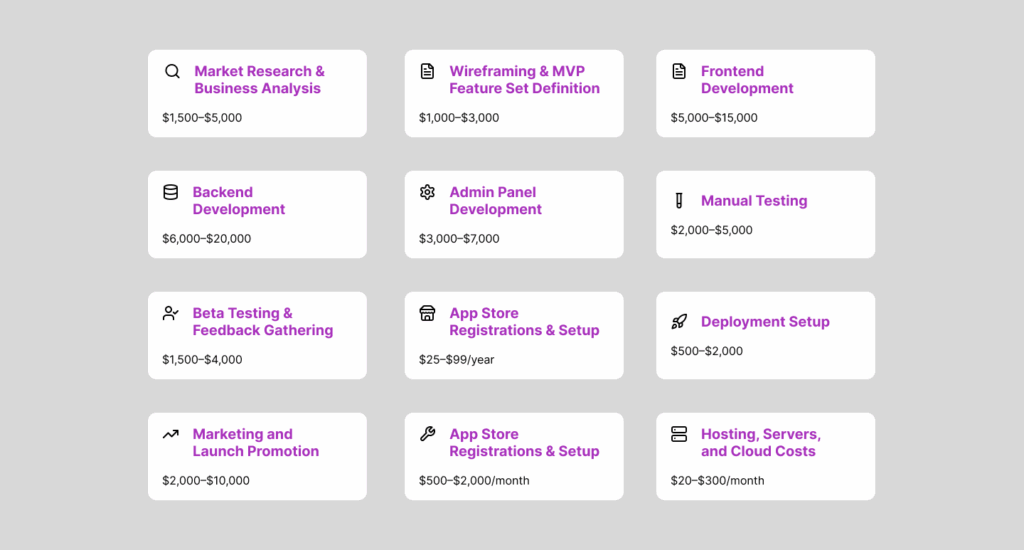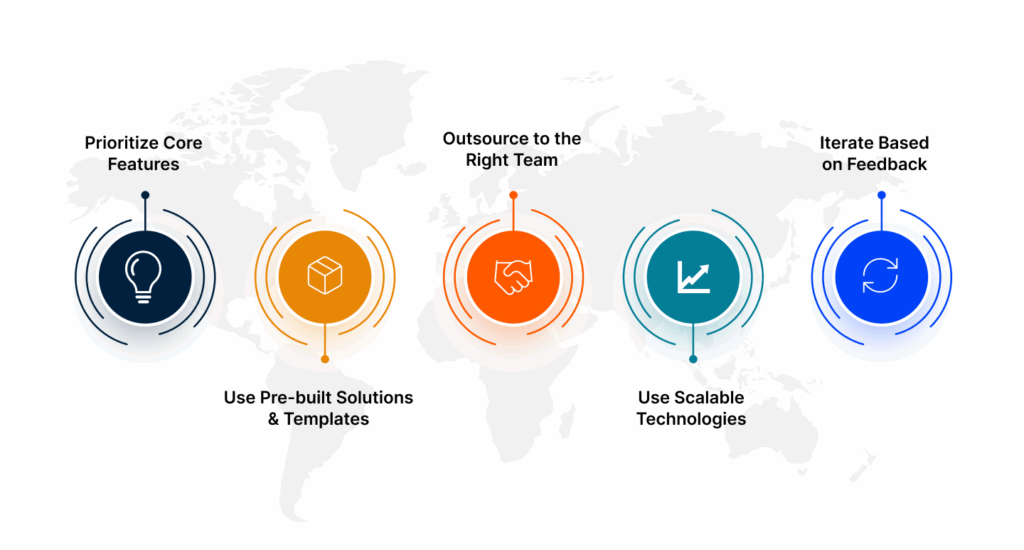|
Getting your Trinity Audio player ready...
|
In today’s competitive startup environment, the ability to fast-track the inception of a product and seek its existence would, often, hold the determination to survive. However, one common problem with the majority of startups is resource depletion in the process of validating their idea. Hence, MVP app development becomes a practicable strategy here.
MVP stands for ‘minimal viable product, a working version of your app that is good enough to be given to the first users for their comments and feedback. Startups can release an MVP to test their idea and learn about market requirements in a real-world situation so that they can make further decisions based on their feedback rather than investing heavily in a full-blown product that may not work.
In this guide, we will explore:
- What MVP app development really means
- Why it’s essential for startups
- A full breakdown of costs
- Factors influencing pricing
- How to minimize expenses without sacrificing quality
- Hidden costs startups must be aware of
Let’s dive deep into the practical side of building an MVP without breaking your startup’s budget with EsferaSoft.
What is MVP App Development and Why is It critical for Startups?
MVP design of minimum viable product, popularly so called by Eric Ries, the author of the Lean Startup. The core thoughts behind MVP are simple: build the least, learn the most. Rather than build every feature their team can imagine, MVPs focus solely on the underpinning functionality that solves a particular problem. It’s about getting a giving, usable version of your idea in the hands of real users to get feedback and improve thereafter based on real market feedback, not mere assumptions.
Start-up youth need MVPs for the following reasons:
- Market Validation:
Only that MVP will allow start-ups to affirm whether there really is any demand for their idea before investment goes too deep. It is basically evidence for product-market fit.
- User Feedback:
Start-ups get direct feedback from early adopters instead of guessing what users want. This helps them prioritise eliminating future feature developments.
- Early Adopters:
An MVP helps you get in touch with and engage early users to become loyal brand ambassadors who can give you positive referrals.
Features of an MVP
An MVP, in proper language, includes:
- A clean user flow
- Core features that deliver primary value
- No extra bells and whistles
- A focus on usability as opposed to visual extravagance
Think of such services as early Instagram—it began photo-sharing and simple filters, not the full-blown social network projects we know of today.
Advantages for Start -Ups
- Lower Initial Costs: You avoid risking spending funds on a product that users do not want.
- Faster Time-to-Market: You can launch, thus starting to learn from the user.
- Reduced Risks of Failure: With direct feedback loops in place, pivoting becomes simple if needed.
- Greater Confidence from Investors: An MVP with traction is more valuable than business-plan projections.
Key Factors Influencing MVP App Development Cost
There are several critical variables used in calculating an MVP’s cost. Knowing them early enough will assist in making wiser budgetary decisions.
Platform Decision: Native Versus Hybrid
Native Apps: Developed for the iOS or the Android platform. They offer outstanding performance, but they are somewhat expensive, as there must be two separate code bases.
Hybrid Apps: Developed using frameworks like Flutter or React Native. Instead, they are much more cost-effective for MVPs, also ensuring speed in development. If your main goal is to test an idea quickly on a wide audience, hybrid development often provides the best value for cost.
Core Features
Each new feature will add time and costs to your development plan. The MVP must stick to:
- Authentication (sign up, log in)
- Profile Management
- Core Functionality (e.g. booking, ordering, chatting)
- Notifications (email, SMS, push)
Do not add other features like payments, multilingual support, or powerful dashboards for now.
App Design
- Simple UI/UX: Focused on clear navigation and ease of use. Quick and cheap to develop.
- Custom UI/UX: More design time and budget implementation but can be significant for brand differentiation.
Startups must lay a balance between functional design and minimal branding for early releases.
Technology Stack
Choosing a proper stack has implications for current costs as well as future scalability. Types of stacks commonly in use are:
- Frontend: React Native, Flutter, Swift (iOS)
- Backend: Node.js, Django, Firebase
Wherever possible, use open-source and community-supported tech with no licensing fees.
Integration Requirements
Some examples of third-party integrations include:
- Payment Gateways (Stripe, PayU)
- Social Media Login APIs (Google, Facebook)
- Analytics Tools (Google Analytics, Firebase)
These integrations extend functions, but the costs increase with their complexity.
Team Composition
- In-house Development: Highly costly owing to salaries, infrastructure, and benefits.
- Freelancers: Economical but involve an element of risk unless properly vetted.
- Agencies: Middle-range to high cost but provide end-to-end solutions and project management expertise.
Outsourcing may greatly lower costs without quality sacrifice if done globally to regions such as Eastern Europe or South Asia.
Timeline and Project Management
A short timeline increases the necessity to put more developers—or overtime—on the job, thus inflating costs. Afterward, the application of Agile project management methodologies can provide further assurance towards maintaining scope and minimising unforeseen spending.
MVP App Development Cost Breakdown
A clear cost structure for MVP development helps startups budget properly:

Planning & Research Costs
Market Research & Business Analysis: $1,500–$5,000
This process includes understanding your competitors, analysing their user personas, and defining value propositions.
Wireframing & MVP Feature Set Definition: $1,000–$3,000
Building the blueprint for your MVP ensures no costly surprises during development.
Design & Development Costs
Frontend Development: $5,000–$15,000
The work involves creating basic user-facing interfaces with limited screens and navigation.
Backend Development: $6,000–$20,000
The work involves setting up databases, server-side logic, authentication systems, and APIs.
Admin Panel Development (optional): $3,000–$7,000
Simple dashboards for user or content management (depends on business needs).
Testing & Quality Assurance Costs
Manual Testing: $2,000–$5,000
The process involves testing functionality, performance, and usability.
Beta Testing & Feedback Gathering: $1,500–$4,000
We are testing the app with a limited number of users to gather valuable insights before the full launch.
Launch Costs
App Store Registrations:
- Google Play: $25 (one-time)
- Apple Store: $99/year
Deployment Setup: $500–$2,000
The deployment setup involves setting up live servers and cloud storage, as well as ensuring a smooth public release.
Marketing and Launch Promotion: $2,000–$10,000
Social media campaigns, influencer outreach, and App Store optimisation (ASO).
Post-launch Maintenance Costs
Bug Fixes and Updates: $500–$2,000/month
Early feedback often reveals edge cases and new requirements.
Hosting, Servers, and Cloud Costs: $20–$300/month
Based on app size, user volume, and database queries.
How to Minimize MVP Development Costs Without Sacrificing Quality

Smart startups know that spending wisely doesn’t mean compromising quality:
Prioritize Core Features
Focus on the minimum necessary features. Steer clear of extraneous features unless they significantly enhance the primary user experience.
Use Pre-built Solutions & Templates
Instead of custom-coding everything, use:
- UI libraries (Material UI, TailwindCSS)
- Backend-as-a-Service (Firebase, AWS Amplify)
- Open-source integrations
The resulting process significantly speeds up development and slashes costs.
Outsource to the Right Team
Agencies and freelancers from countries with favourable exchange rates can offer world-class developments at a fraction of Western prices.
Look for teams with:
- Transparent pricing
- Agile processes
- Positive client testimonials
Use Scalable Technologies
Choose technologies that won’t require a rebuild when scaling:
- Cloud hosting (AWS, Azure)
- Frameworks supporting future feature expansion
A wise technology choice today saves thousands later.
Iterate Based on Feedback
Ship early, gather feedback, and improve gradually. Avoid developing everything at once—iteration is cheaper than assumption.
How Esferasoft Helps Startups Build Cost-Effective MVPs
At Esferasoft, we help startups realise their ideas while staying economical. We start with the following services.
- Lean Development Solution: We build what is required at the moment without wasting time and resources.
- Rapid Prototyping: The design and development teams coordinate in almost real time to minimise wasted cycles.
- Global Talent Pool: A seasoned team of developers, designers, and strategists.
- Agile Project Management: We adapt to changes almost seamlessly and eliminate scope creep to the largest extent possible.
Success Stories
We have partnered with multiple startups across the fintech, health tech, e-commerce, and ed-tech industries to help them launch MVPs with later funding, scaling, and expansion to global markets.
The Esferasoft MVP Upgrade supports its startup clients with:
- Faster time-to-market
- Predictable costs
- High-quality MVPs built for real-world growth
- Hidden Costs to Consider in MVP App Development
Startups usually underestimate several factors related to cost:
- Unexpected Feature Requests
Stakeholders often change or expand requirements mid-project. Build some flexibility into your budget (10-15% contingency).
- Quality Assurance After Launch
Even with all the testing in the world before launch, real-life users tend to find the bugs that were never anticipated.
- Marketing and User Acquisition Costs
Budget for visibility in even the best MVP:
- Paid ads
- Influencer collaborations
- App store promotions
- Ongoing Maintenance
Apps require updates to remain functional and secure. Ongoing costs involve the following:
- Server scalability
- Bug fixes
- Security patches
Conclusion:
Developing an MVP requires strategic investment rather than shortcuts. By focusing on the core problem, limiting feature sets, using the right technologies, and partnering with efficient teams, startups can validate ideas faster, cheaper, and smarter.
Understanding where your money will go—from planning to post-launch maintenance—can make the difference between a successful launch and a costly misstep.
Are you looking to launch your MVP the smart way? Contact us today at +91-772-3000-038 for a customised MVP app development estimate and take one step closer to turning your startup dreams into reality!

